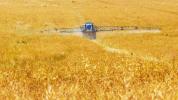H2020 FLEXIGROBOTS Project: Flexible robots for intelligent automation of precision agriculture operations
- Type Project
- Status Signed
- Execution 2021 -2023
- Assigned Budget 6.994.698,5 €
- Scope Europeo
- Main source of financing Horizon 2020
- Project website FLEXIGROBOTS
In an effort to improve agricultural production, the adoption of agricultural robots is increasing. However, the number of discrete tasks that must be automated significantly reduces the flexibility of current solutions, impacting efficiency and limiting their adoption. The EU-funded FLEXIGROBOTS project aims to develop a platform to help build heterogeneous multi-robot systems, enabling significantly improved flexibility by utilizing existing robots for multiple tasks. This could help generate higher-value data from diverse sources and sensors, increasing operational autonomy and accuracy, while significantly reducing costs and encouraging investment in robotics.
Agricultural robotics solutions can integrate a variety of robots for a variety of specific monitoring and intervention tasks, increasing farm productivity, efficiency, and sustainability by supporting automated precision farming operations. Despite growing investment by farmers in agricultural robots, most deployable robotic systems are intended to automate only specific tasks. The wide variety of tasks that must be completed in a single precision farming operation or mission makes it extremely uneconomical to address their automation with task-specific robots.
These challenges result in a lack of flexibility in current heterogeneous multi-robot systems, posing low returns on investment and high risks for farmers. To become profitable, heterogeneous multi-robot systems must become more flexible by employing more versatile (e.g., multitasking) robots that collaborate to accomplish complex missions; ensuring scalable human supervision and intervention through adaptive mission control mechanisms (e.g., without information overload/overwhelming effort on the part of the farmer); and allowing the farmer to benefit from operational data from the robotics. FlexiGroBots proposes a platform for the development of heterogeneous multi-robot systems and applications that enables:
- Greater versatility by using the same robots for different observation and intervention tasks, on different missions, throughout the crop's life cycle.
- Greater cooperation between heterogeneous robots (ground and air) to accomplish more complex missions.
- More valuable data to generate accurate insights into fields, crops, and robotic operations by combining data from IoT sensors, satellites, and data collected by robots.
- Greater autonomy for real-time adaptation of mission plans, as well as robot behavior at the crop level, given operating conditions and real-time information.
- Greater precision to perform specific tasks in a highly localized manner, increasing accuracy and reducing costs.
Artificial intelligence helps coordinate precision farming tasks. An AI-based platform seeks to coordinate fleets of robots to automate many tedious agricultural tasks. In the digital age, no sector is left behind. Even traditional sectors like agriculture are becoming increasingly digitalized. For example, farmers across Europe now use technology and data for everything from automatic control of agricultural machinery to fertilizer application, livestock tracking, soil quality monitoring, and crop yield improvement. The problem with this field, often referred to as precision farming, is that it tends to be quite fragmented, with separate solutions for each task. But what farmers need are comprehensive, yet flexible and easy-to-use solutions capable of automating all of these tasks in a coordinated manner.
This is where the EU-funded FLEXIGROBOTS project comes in. By using cutting-edge technologies such as the Internet of Things, big data, artificial intelligence (AI), and robotics, the project aims to revolutionize agriculture. “FLEXIGROBOTS addresses the growing need for and adoption of new robotic technologies by ensuring the efficient automation of precision farming operations and the flexible use of multi-robot systems,” says Raquel Lazcano, R&D Team Leader at Atos IT Solutions and Services Iberia, the project’s coordinating partner. An AI platform for multiple robots performing multiple precision farming tasks The project relies on an AI platform for building heterogeneous systems with multiple robots that can collaborate on complex precision farming missions. “Our platform seeks to enable fleets of heterogeneous robots for precision farming tasks, where any technology provider can participate and where farmers have full control of the data collected in their fields,” explains Lazcano.
With this, the project seeks to bring greater versatility to precision agriculture, allowing the same robots to be used for different tasks. Furthermore, the platform is designed to ensure greater cooperation between ground and aerial robots and increase the use of data throughout the agricultural value chain. The FLEXIGROBOTS platform also seeks to bring greater autonomy and precision to precision agriculture-based tasks, while reducing the level of expertise required to use such technologies. "By simplifying the technical expertise required to put AI models into production, we have opened the door to the creation of powerful applications to meet the needs of farmers," adds Lazcano. The platform not only meets the International Data Spaces Association's benchmark for data sharing, but also adheres to the AI trustworthiness requirements set by the European Commission's High-Level Expert Group on AI.
Demonstrating the Benefits of AI-Powered Precision Agriculture The platform has been tested in three large-scale, real-world pilots with different crop types and in several geographic regions. For example, in Spain, the project demonstrated the robots' high capacity and versatility to carry out different tasks in vineyards, contributing to the economic profitability and quality of the grapes used to produce wine. In Finland, researchers used FLEXIGROBOTS technologies to control pests and guide heavy machinery, while in Lithuania and Serbia they were used to automate tedious tasks such as extracting and analyzing soil samples in blueberry plantations. "These pilots demonstrate the numerous benefits of adopting a unified, AI-powered approach to precision agriculture," concludes Lazcano.
The project is currently working to further develop its technology, with the goal of providing market-ready applications. For example, CSIC, one of the project partners, is already seeking to patent an autonomous robotic harvesting assistance system. Meanwhile, Atos is exploring the inclusion of the AI platform within its product portfolio.
- ATOS IT SOLUTIONS AND SERVICES IBERIA SL (ATOS IT)







